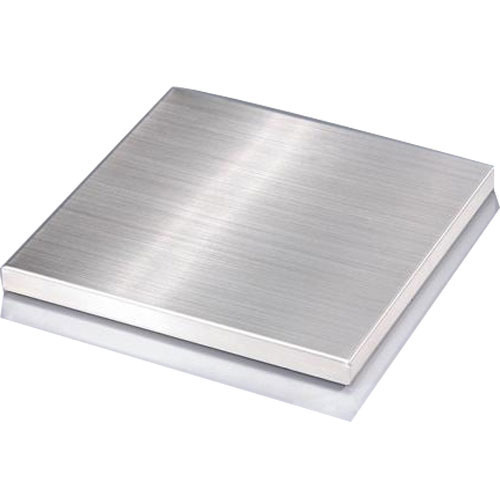Stainless steel plates are divided into hot-rolled and cold-rolled according to the manufacturing method, including thin cold steel plates with a thickness of 0.02-4 mm and medium and thick plates with a thickness of 4.5-50 mm.
According to the organizational characteristics of the steel type, it is divided into 5 categories: austenite, austenite-ferrite, ferrite, martensite, and precipitation hardening. It is required to withstand the corrosion of various acids such as oxalic acid, sulfuric acid-ferrous sulfate, nitric acid, nitric acid-hydrofluoric acid, sulfuric acid-copper sulfate, phosphoric acid, formic acid, and acetic acid. It is widely used in industries such as chemical, food, medicine, papermaking, petroleum, and atomic energy, as well as various parts of construction, kitchen utensils, tableware, vehicles, and household appliances. In order to ensure that the mechanical properties of various stainless steel plates such as yield strength, tensile strength, elongation, and hardness meet the requirements, the steel plates must undergo heat treatment such as annealing, solution treatment, and aging treatment before delivery.
Stainless steel plate is a commonly used metal material with many unique characteristics and advantages. The characteristics and applications of stainless steel plates will be introduced in detail below.

First of all, stainless steel plates have excellent corrosion resistance. Stainless steel is made of alloys of iron, chromium, nickel and other elements, so it can effectively resist the erosion of most chemicals, including acids and alkalis. This makes stainless steel plates widely used in industries such as chemical industry, food processing, and pharmaceuticals, and can work stably for a long time in corrosive environments.
Secondly, stainless steel plates are heat-resistant and low-temperature resistant. Stainless steel has a high melting point and can maintain a stable structure and performance in high temperature environments. At the same time, stainless steel is not easily affected by low temperatures such as freezing, and still maintains high toughness and strength, so it can still perform excellent performance at extreme temperatures.
Third, stainless steel plates have good mechanical properties. Stainless steel plates have high strength, toughness and hardness, can withstand greater forces and pressure, and also have good seismic resistance. This makes stainless steel plates widely used in construction, machinery manufacturing and other fields.
In addition, stainless steel plates are also easy to process, maintain and beautify. Stainless steel plates are easy to cut, weld, bend and other processing operations, and can meet the needs of various complex shapes. At the same time, the surface of stainless steel plates is smooth, easy to clean, not easy to accumulate dust and bacteria, and maintain long-term beauty and hygiene.
In summary, stainless steel plates have the characteristics of corrosion resistance, high and low temperature resistance, good mechanical properties, easy processing and maintenance, etc. Based on these characteristics, stainless steel plates have been widely used in various industries, such as building decoration, food processing, chemical technology, and pharmaceuticals. For enterprises and individuals using stainless steel plates, they should choose the appropriate stainless steel material, combined with the required performance and environmental requirements, to ensure the best use effect.
According to the organizational characteristics of the steel type, it is divided into 5 categories: austenite, austenite-ferrite, ferrite, martensite, and precipitation hardening. It is required to withstand the corrosion of various acids such as oxalic acid, sulfuric acid-ferrous sulfate, nitric acid, nitric acid-hydrofluoric acid, sulfuric acid-copper sulfate, phosphoric acid, formic acid, and acetic acid. It is widely used in industries such as chemical, food, medicine, papermaking, petroleum, and atomic energy, as well as various parts of construction, kitchen utensils, tableware, vehicles, and household appliances. In order to ensure that the mechanical properties of various stainless steel plates such as yield strength, tensile strength, elongation, and hardness meet the requirements, the steel plates must undergo heat treatment such as annealing, solution treatment, and aging treatment before delivery.
Stainless steel plate is a commonly used metal material with many unique characteristics and advantages. The characteristics and applications of stainless steel plates will be introduced in detail below.

First of all, stainless steel plates have excellent corrosion resistance. Stainless steel is made of alloys of iron, chromium, nickel and other elements, so it can effectively resist the erosion of most chemicals, including acids and alkalis. This makes stainless steel plates widely used in industries such as chemical industry, food processing, and pharmaceuticals, and can work stably for a long time in corrosive environments.
Secondly, stainless steel plates are heat-resistant and low-temperature resistant. Stainless steel has a high melting point and can maintain a stable structure and performance in high temperature environments. At the same time, stainless steel is not easily affected by low temperatures such as freezing, and still maintains high toughness and strength, so it can still perform excellent performance at extreme temperatures.
Third, stainless steel plates have good mechanical properties. Stainless steel plates have high strength, toughness and hardness, can withstand greater forces and pressure, and also have good seismic resistance. This makes stainless steel plates widely used in construction, machinery manufacturing and other fields.
In addition, stainless steel plates are also easy to process, maintain and beautify. Stainless steel plates are easy to cut, weld, bend and other processing operations, and can meet the needs of various complex shapes. At the same time, the surface of stainless steel plates is smooth, easy to clean, not easy to accumulate dust and bacteria, and maintain long-term beauty and hygiene.
In summary, stainless steel plates have the characteristics of corrosion resistance, high and low temperature resistance, good mechanical properties, easy processing and maintenance, etc. Based on these characteristics, stainless steel plates have been widely used in various industries, such as building decoration, food processing, chemical technology, and pharmaceuticals. For enterprises and individuals using stainless steel plates, they should choose the appropriate stainless steel material, combined with the required performance and environmental requirements, to ensure the best use effect.









